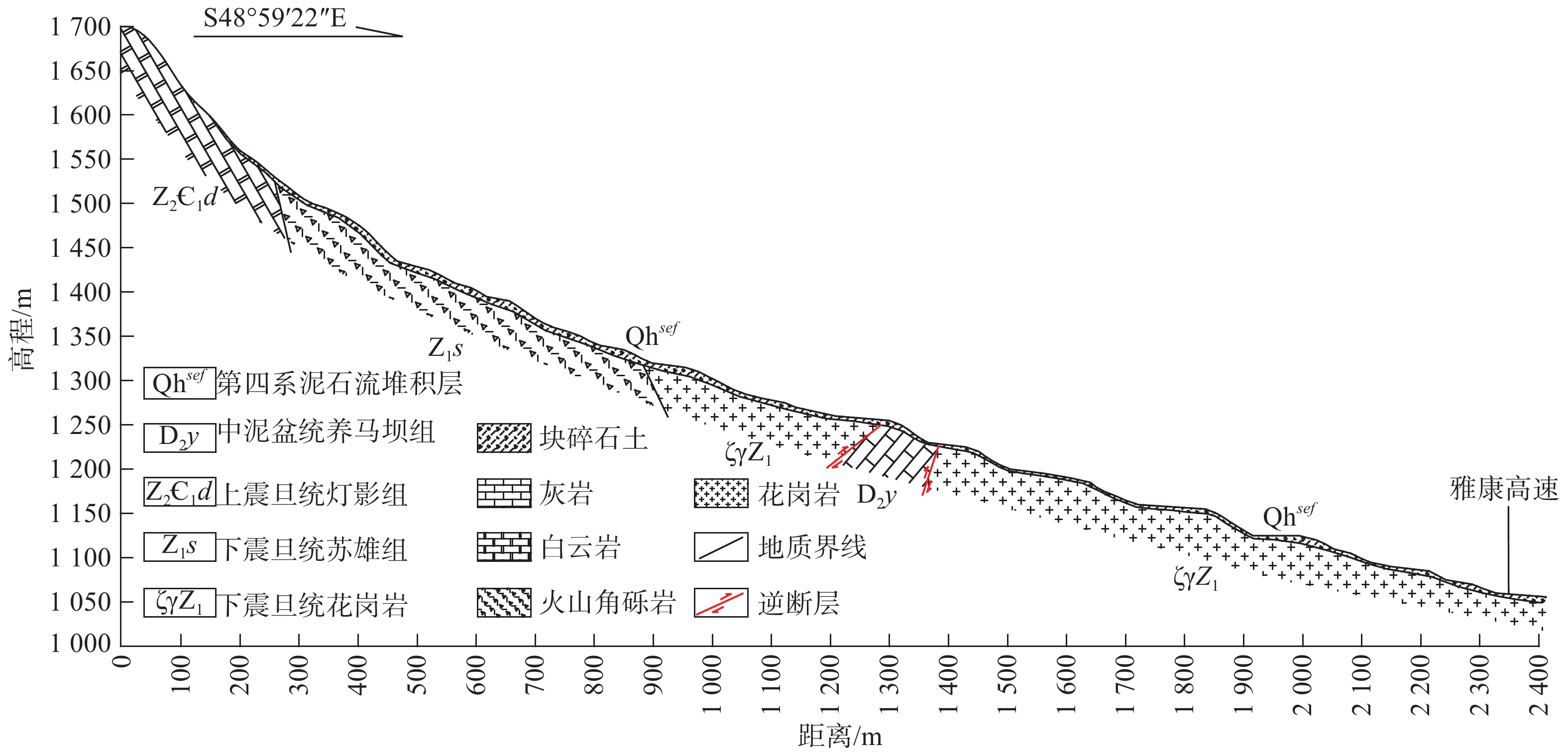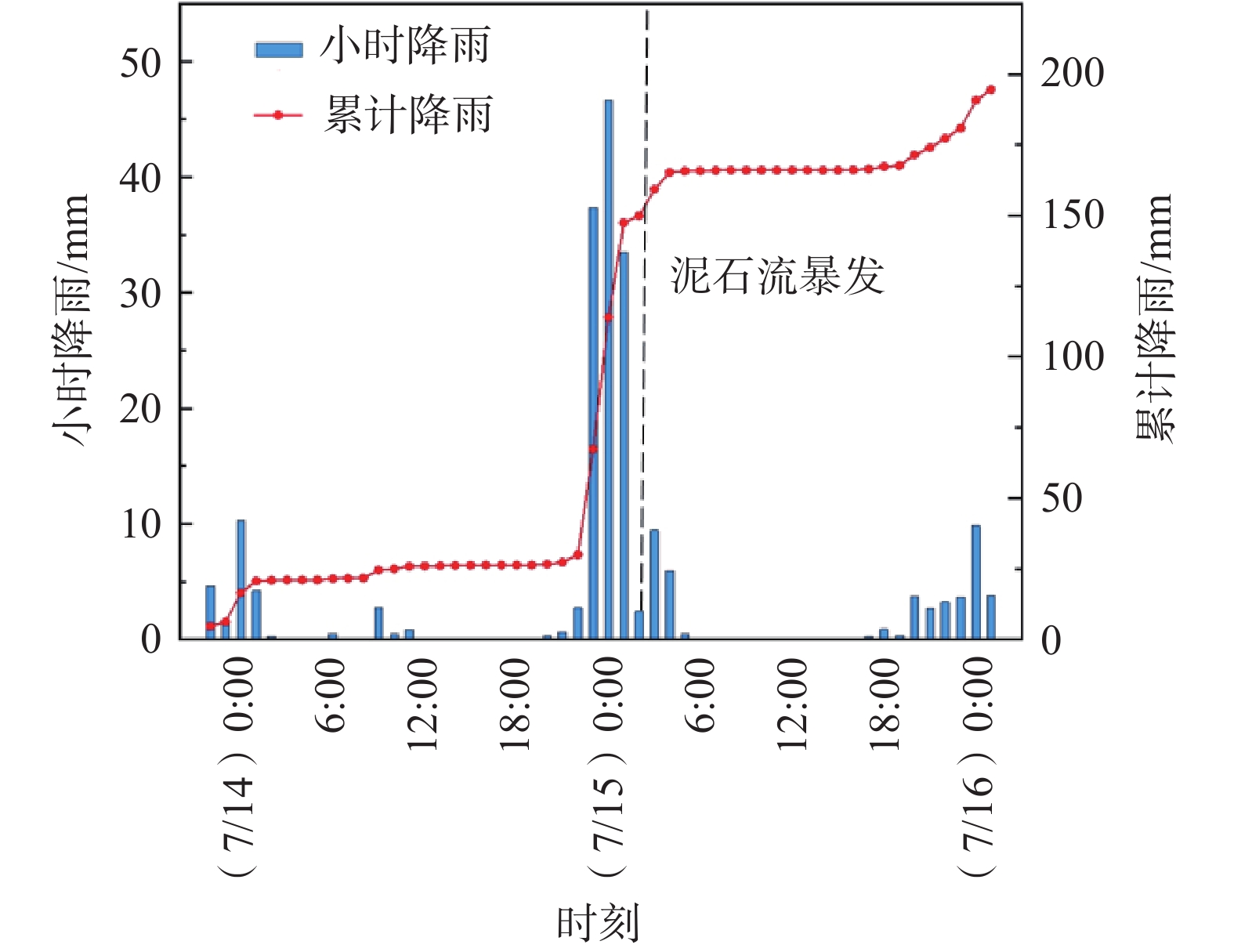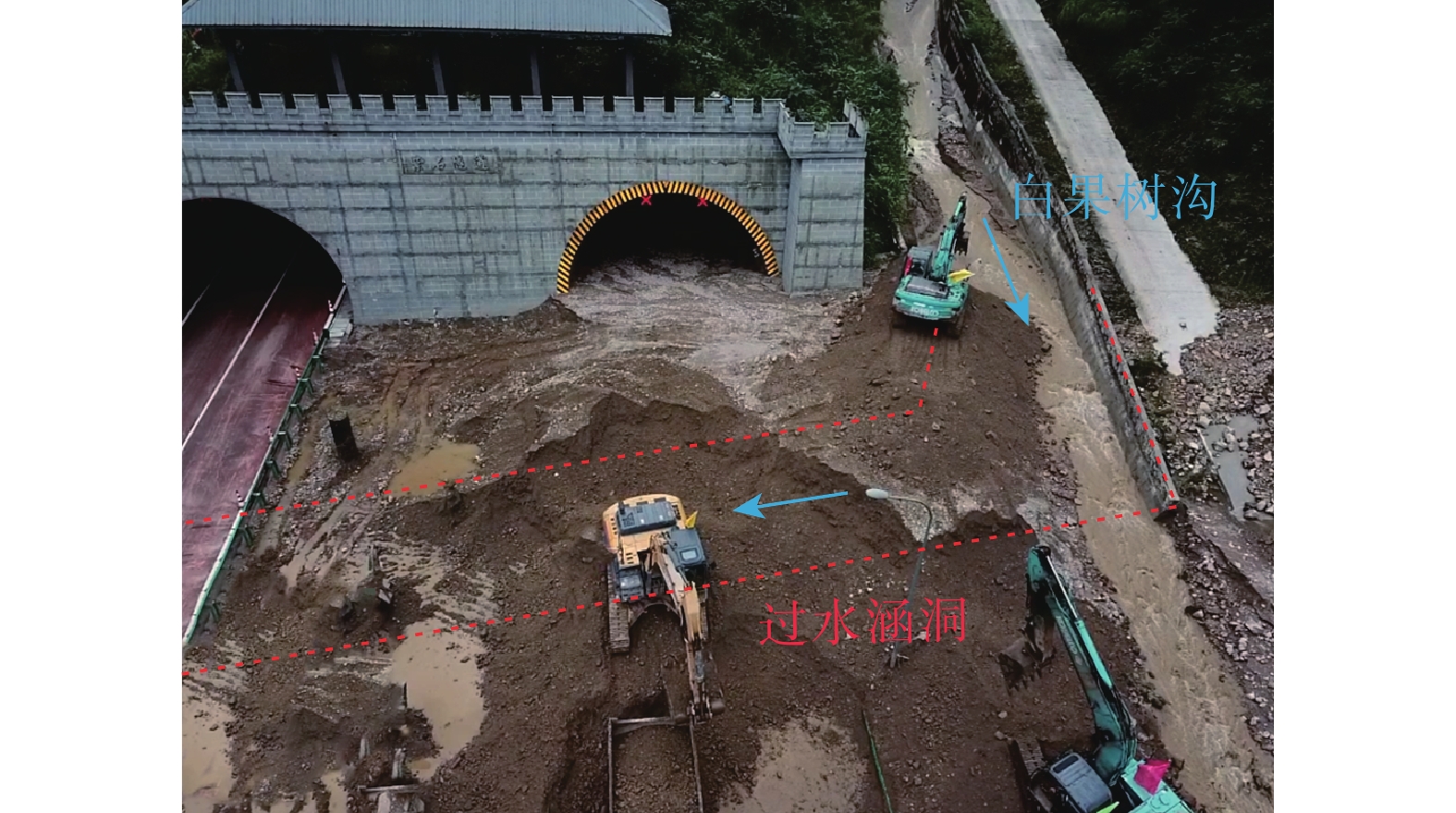Mechanism of the “7•15” debris flow in Baiguoshu gully, Tianquan County, Sichuan Province
-
摘要:
相较于宽缓沟道型泥石流,小流域窄陡沟道型泥石流具有更高的隐蔽性和突发性,揭示此类灾害成灾机理无疑对工程治理及灾害预防具有重要意义。文章以2021年发生的四川省天全县白果树沟“7•15”突发性泥石流为例,借助野外调查、无人机航测与RAMMS流体动力学模拟,揭示了此次泥石流的成灾过程。结果表明:白果树沟泥石流是累计前期降雨和短时强降雨共同作用的结果,其起动源于上游饱水物源被山洪揭底,而沿途侧蚀冲刷沟岸形成的滑坡为泥石流提供了物源补给,沟内局部堵溃后又进一步放大流量、导致沟口成灾,淤埋雅康高速公路路面。从发展趋势看,白果树沟现阶段物源丰富,水动力条件良好,仍存在暴发泥石流的可能性。
Abstract:Compared to wide-gentle debris flows, narrow-steep gully debris flow in small watersheds are characterized by their invisible and sudden nature. Therefore, understanding the mechanism behind such disasters are crucial for engineering management and disaster prevention. This paper presents a case study of the “7•15” debris flow that occurred in Baiguoshu gully, Tianquan County, Sichuan Province in 2021. The process of this debris flow was thoroughly investigated through field surveys, aerial photography, and hydrodynamic simulations using RAMMS. The findings revealed that Baiguoshu gully debris flow was triggered by the cumulative antecedent rainfall and short-term heavy rainfall. The mobilized materials during the “7•15” debris flow consisted of saturated materials upstream that were eroded by floods, as well as landslides triggered by bank erosion along the gully. Subsequently, the amplification of flow discharge caused by blockages and bursting in the main channel resulted in a disaster at the gully outlet and the buried of the Yakang Expressway. The Baiguoshu gully is prone to debris flow occurrences due to the abundance of source materials and favorable hydrodynamic conditions.
-
Keywords:
- narrow-steep gully /
- debris flow /
- small watershed area /
- disaster mechanism /
- RAMMS
-
0. 引言
白龙江流域舟曲段地处青藏高原东北缘,北接黄土高原,东望秦岭,向南为四川盆地,区域内地质构造强烈、地形起伏大、沟深坡陡,是典型的高山峡谷地貌,堆积体滑坡十分发育[1]。该地区的堆积体滑坡上覆土体结构松散,通常规模巨大,十分容易发生滑动,造成堵江等灾害,每年造成的人员伤亡和经济损失巨大[2 − 3]。抗滑桩在该区域的滑坡治理工程中已经得到广泛应用,但有关抗滑桩承载特性研究十分匮乏[4 − 5]。
现场监测是研究抗滑桩的承载特性的有效手段[6 − 10],目前对于抗滑桩的内力监测分析已有了较多的研究成果,各种监测技术和分析理论不断完善。张会远等[11]监测了抗滑桩靠山侧最中部位置钢筋的应力,通过单筋矩形截面受弯模型得到桩身弯矩分布曲线。任伟中等[12]通过在抗滑桩迎滑面中部沿长度方向上钻孔埋设测斜仪,根据弹性地基梁法由桩身变形来分析桩身承载特性。王秀丽等[13]长期监测了锁儿头滑坡矩形抗滑桩四个角部的钢筋应力,同侧钢筋应力取平均值进行计算,得出了抗滑桩在使用过程中的内力变化特征曲线;黄雪峰等[14]通过监测悬臂桩在不同开挖工况条件下拉压两侧钢筋应力,研究了其内力和土体水平应力分布特点。上述学者将抗滑桩受力状态简化为仅受到弯曲作用,认为全桩的应力状态均为迎滑面受拉、背滑面受压,桩截面内力计算误差较大且无法进行优化,因此,需要通过现场监测进一步研究堆积体滑坡中抗滑桩的承载特性。
有限元强度折减法是常用的边坡稳定性分析方法,也被用于计算滑坡支挡结构内力和分析边坡加固机制等研究。张怡颖等[15]通过FLAC3D数值模拟软件,分析了扎马古滑坡体在不同工况下的变形情况,发现在暴雨与强震耦合作用工况下,易产生贯通滑动面,会导致滑坡失稳滑动。Galeandro等[16]通过数值模拟,研究了在不同降雨工况下的边坡稳定性,短时强降雨作用下滑坡引发地表变形更大。陈冲等[4]提出了一种采用结构单元和实体单元相结合的复合抗滑桩模型,能在真实模拟抗滑桩性能的同时快速提取桩身内力。陈伟志[17]等依托林织铁路滑坡案例,提出了框架式抗滑支挡结构加固巨型古滑坡的设计方法与施工技术,并通过数值模拟计算了支挡结构的内力,分析了加固机制。郑颖人等[18]认为强度折减法既可以考虑锚索抗滑桩与岩土之间的相互作用关系,又能够算出极限状态下锚索抗滑桩中的内力,相比于传统分析方法有较大的优越性。
综上所述,本文依托舟曲江顶崖大型堆积体滑坡治理工程,对主剖面位置处的抗滑桩布置钢筋应力计,通过现场监测获取3 a的动态数据,对桩身承载特性与进行深入研究。此外,通过ABAQUS对治理后的滑坡体进行数值模拟分析,以评价其治理后的稳定性。
1. 滑坡概况
1.1 工程地质条件
江顶崖滑坡体位于白龙江左岸,该区域谷道狭窄、陡坡流急,属于构造侵蚀山地。滑坡区位于舟曲—武都地震亚带,属于坪定—化马断裂带,新构造运动强烈,大型断裂带滑坡发育。据2017年收集的舟曲县气象站统计资料,白龙江流域舟曲段降雨主要在夏季,日最大降雨量为96.7 mm。
受汛期连续强降雨及白龙江冲刷坡脚的影响,2018年7月12日,舟曲县南峪乡江顶崖发生山体滑坡,造成堵江,致使原本宽约36 m的江面最窄处仅有5 m。滑坡灾害的发生导致上游江水水位上升,最高可达7~8 m,导致上游村庄被淹,滑坡前缘国道被冲毁,造成严重经济损失,并严重威胁下游居民的生命财产安全。本次发生滑动的主要为H1滑体(图1),长462 m,平均宽度210 m,体积338.1×104 m3,属特大型地质灾害。
江顶崖滑坡为南峪滑坡群的一部分,南峪滑坡历史上发生多次滑动,因此江顶崖滑坡土体为老滑坡堆积体。其中滑体土为松散的碎石土,土体多呈黄褐色,粒径大小悬殊,结构松散,呈干燥—稍湿状,其力学性质差,渗水性强,稳定性差。滑带土为含砾黏土及炭质板岩碎屑,结构较为致密,呈灰黑色,含水量较高,手搓后呈粉末状或泥状,强度较低,属易滑地层。根据前期研究成果可知,滑坡机理为前期地震作用改变土体物理力学性质,然后在汛期连续强降雨的渗透作用以及白龙江冲刷坡脚条件下所诱发[19 − 21]。
1.2 滑坡破坏
滑坡发生后,对滑坡进行现场勘察,发现滑体后缘及侧缘拉裂形成了高陡的后壁,在后壁出现了大量弧形、走向与后壁一致的裂缝,两侧侧壁沿滑坡滑动方向也出现了大量的裂缝,致使滑坡后缘及两侧侧缘分别形成了影响变形区。滑坡体变形迹象明显,由于滑坡体蠕动下滑后,上部土体推挤中前部土体,在滑坡中下部形成了百余条剪切裂缝,如图2所示。
2. 滑坡治理工程现场监测方案
2.1 滑坡治理工程概况
为防止H1堆积体滑坡继续滑动,首先对滑坡后缘及侧壁进行削方处理,在后缘采用钢筋混凝土框架预应力锚索进行支护,并且在滑坡前缘布置抗滑桩。其中,前缘治理抗滑桩为主要的抗滑桩支护结构,抗滑桩截面尺寸3.0 m×4.0 m,开挖桩孔尺寸为3.7 m×4.7 m,抗滑桩桩长为40 m,桩心距为5.5 m,总共布置39根。迎滑面钢筋布置三排直径为32 mm的HRB400级钢筋,共170根。背滑面采用单排布筋,每两根一组,共30根。江顶崖H1滑坡治理工程的布置情况如图3(a)所示。
2.2 监测试验传感器布置
为了研究白龙江流域舟曲段堆积体滑坡中大口径抗滑桩的承载特性,选取滑坡前缘主剖面位置处的抗滑桩为试验桩,见图3(a),对其钢筋应力进行监测。在抗滑桩施工过程中安装现场监测传感器,分别在抗滑桩迎滑面、背滑面的中部和角部布置钢筋应力计,其竖向间距为5m,每个竖向监测方向上布设7个测点,共布设了28个钢筋应力计。图4为抗滑桩传感器布置图。
按照前述监测方案在江顶崖滑坡现场埋设监测传感器,自2019年8月开始每日于0:00和12:00收集2次监测数据,对滑坡治理抗滑桩的应力应变进行持续监测,并通过无线远程监测系统进行数据采集。现场监测传感器安装见图5。
3. 抗滑桩监测承载特性结果分析
试验桩靠江侧角部的监测钢筋应力随时间变化曲线如图6所示。由图可知,监测抗滑桩钢筋应力还在缓慢增加,且当前桩身钢筋的应力增长速率较施工结束时明显减缓。截至2021年12月20日,钢筋单根最大拉应力在30 m深处为44.5 MPa,最大压应力的绝对值在35 m深处约为13.5 MPa。支护抗滑桩的钢筋应力值均低于钢筋抗拉强度设计值,处于弹性工作状态。
抗滑桩中部各深度钢筋应力分布曲线见图7。由图7(a)迎滑面中部钢筋应力曲线可知,试验桩在5 m至10 m之间以及35 m深度附近钢筋拉应力增长幅度较大,在25 m至30 m之间钢筋压应力增长明显。此外,迎滑面中部钢筋应力曲线均出现多个极值,试验桩迎滑面中部的钢筋拉应力存在5 m、20 m、35 m共3个极值,最大拉应力在约35 m深处,为31.4 MPa。抗滑桩迎滑面中部钢筋在25 m深度出现压应力最大值,其绝对值为20.6 MPa。由图7(b)背滑面中部钢筋应力曲线可知,试验桩在5 m和30 m处存在拉应力极值,最大拉应力在约30 m深处,为39.9 MPa;最大压应力出现在15 m深处,其绝对值为5.7 MPa。抗滑桩在35 m深度以下的背滑面中部钢筋应力均为压应力,对应的迎滑面中部钢筋拉应力数值较大,表明此深度范围内的抗滑桩受到较大的弯曲作用。滑坡工程地质剖面图,见图3(b),中的滑动面深度位置也在地下约20 m和约35 m深度处,这与图7中钢筋应力极值点位置相符合,证明抗滑桩的受力效果较好。
抗滑桩角部监测钢筋应力如图8所示。由图8可知,抗滑桩迎滑面角部的钢筋单根拉应力在5 m、20 m、35 m深度处出现极值,这与迎滑面中部监测钢筋应力曲线变化趋势一致;迎滑面角部钢筋最大压应力在30 m深处的绝对值约为31.1 MPa。背滑面角部的钢筋应力曲线分布形式与图7(b)所示背滑面中部基本一致,最大拉应力在30 m深处约为44.5 MPa,最大压应力在35 m深处的绝对值约为13.5 MPa。
对比图7与图8可知,试验桩的迎滑面与背滑面两侧的钢筋在5 m、10 m、20 m深度处均主要表现为拉应力,这种现象在3根监测试验桩上均出现,这与现行规范抗滑桩设计时截面前后两侧拉压应力状态相反的情况不符。由此可知,传统抗滑桩弯矩分析中仅考虑横力弯曲作用属于过度简化,抗滑桩沿长度方向上还受到较大的拉力作用。分析上述现象出现的原因,当滑坡发生蠕滑时滑带土体相对滑动,抗滑桩表面受到沿桩身长度方向上的土体摩擦力作用,表现为拉拔力。这表明抗滑桩主筋的拉应力并非全部由桩身弯曲所提供,还有部分来自于桩身受拉;应力具有叠加效应,当摩擦力对桩产生的拉应力大于弯曲压应力时,会使得该侧的钢筋应力整体表现为拉应力,从而出现抗滑桩前后两侧钢筋均受拉的应力状态。因此,抗滑桩在复活堆积体滑坡中所受到的摩擦力导致拉拔作用,比现行规范中抗滑桩仅为受弯状态的假定更为复杂,采用规范法设计抗滑桩时需要进行修正。
4. 基于数值模拟的滑坡治理效果评价
4.1 建立滑坡模型
采用ABAQUS工程模拟有限元软件,建立滑坡的三维模型对其稳定性进行分析,模型尺寸及参数与原型一致。滑坡模型从上至下主要有滑体、滑带以及滑床共3层土体,土体的材料属性采用摩尔-库仑本构模型,参数取值参照地勘以及室内试验结果[19 − 20];支护结构均为混凝土结构,材料属性采用弹性材料,滑坡土体与支护结构材料参数见表1。边界条件设置时,支护结构与土体之间的接触采用摩擦接触,摩擦系数为0.3。最不利工况为地震和降雨耦合作用,降雨计算工况将土层参数中黏聚力和内摩擦角折减,地震工况选择峰值加速度0.21g地震波进行数值模拟。
表 1 材料物理力学参数Table 1. Physical and mechanical parameters of materials材料 弹性模量
/MPa泊松比 重度
/(kN·m−3)黏聚力
/kPa内摩擦角
/(°)滑体土 18 0.32 21 12 22 滑带土 12 0.35 20.5 9 18 滑床 100 0.26 26 18 36 混凝土 3×104 0.2 25 − − 4.2 基于数值模拟的滑坡水平位移分析
江顶崖滑坡在治理工程完工后最不利工况下的位移云图如图9所示。由图9可知,滑坡的最大水平位移出现在滑坡体的后部未支护位置,为33.93 mm。而本次滑动的H1滑体在治理后的位移值很小,表明滑坡支护结构发挥作用,滑坡体处于基本稳定状态。从抗滑桩附近的水平位移云图(图10)可以看出该区域的土体水平位移很小,说明在治理工程施工完成后,前缘支护抗滑桩可有效控制滑坡的变形。并且,桩前土体的水平位移较桩后土体的水平位移大。
抗滑桩的桩身水平侧移云图及桩身侧移见图11。从图11中可以看出抗滑桩顶端在施工完成后发生了4.07 mm的水平位移,然而桩身下部位移值很小,结合桩身内力监测结果分析所得抗滑桩承载特性可知,抗滑桩在经过一定的弯曲变形之后,与土体之间形成了新的变形协调,证明了其对边坡整体加固效果的有效性。
5. 讨论
5.1 滑坡中可能存在的多级滑面
根据前文监测结果分析可知,试验桩迎滑面中部的钢筋拉应力存在5 m、20 m、35 m共3个极值,抗滑桩迎滑面角部的钢筋单根拉应力在5 m、20 m、35 m深度处也出现了极值,这与迎滑面中部监测钢筋应力曲线变化趋势一致,而抗滑桩在35 m深度以下的背滑面中部钢筋应力均为压应力,对应的迎滑面中部钢筋拉应力数值较大,表明此深度范围内的抗滑桩受到较大的弯曲作用。这些都与《滑坡防治设计规范》GB/T 38509—2020基于单滑面简化计算模型不符,说明该堆积体滑坡内部有较为明显的分层,可能存在新老不同的多级岩土体,即该滑坡可能存在多级滑面,后续应该对该滑坡是否具有多级滑面的特性进行进一步的研究。
5.2 抗滑桩的受力模式及承载特性探讨
试验桩在5~10 m以及35 m深度附近钢筋拉应力增长幅度较大,在25~30 m钢筋压应力增长明显。由图7和图8相互对比可知,3根监测试验桩的迎滑面与背滑面两侧的钢筋在5 m、10 m、20 m深度处均主要表现为拉应力,而现行规范抗滑桩设计时截面前后两侧拉压应力状态相反。
推测两侧钢筋均表现为拉应力的原因可能是:由于受到滑坡推力作用,桩身发生了一定的弯曲变形和桩土间的相对运动,迎滑侧的土体相对桩身向上运动,造成桩土摩擦,表现为桩身在土体作用下向上“受拉”;背滑侧桩身弯曲,导致桩土间摩擦,总体也表现为受拉,其本质都是桩身与岩土体的相对运动。因此,抗滑桩主筋的拉应力并非全部由桩身弯曲所提供,还有部分来自于桩身受拉;应力具有叠加效应,当摩擦力对桩产生的拉应力大于弯曲压应力时,会使得该侧的钢筋应力整体表现为拉应力,从而出现抗滑桩前后两侧钢筋均受拉的应力状态。
6. 结论
(1)2018年1月21日江顶崖滑坡形变量最大为16 mm,到2018年7月8日滑坡发生前,累计形变量达到最大值41 mm,而数值模拟分析显示,经过治理后的抗滑桩顶端在施工完成后仅发生了4.07 mm的水平位移,监测结果表明使用抗滑桩对该滑坡进行治理取得了较好的效果。
(2)由数值模拟可知,在地震和降雨耦合作用下江顶崖滑坡的最大水平位移出现在滑坡体的后部未支护位置,为33.93 mm。在治理工程施工完成后,桩前土体的水平位移较桩后土体的水平位移大,前缘支护抗滑桩可有效控制滑坡的变形。在加入抗滑桩后,抗滑桩顶端发生了4.07 mm的水平位移,相较于未治理的江顶崖滑坡变形明显减小,数值模拟分析结果表明抗滑桩治理效果较好。
(3)3根试验桩的迎滑面与背滑面两侧的钢筋在5 m、10 m、20 m深度处均主要表现为拉应力,说明抗滑桩两侧沿长度方向上受到较大的拉力作用,其原因可能是当滑坡发生蠕滑时滑带土体相对滑动,抗滑桩表面受到沿桩身长度方向上的土体摩擦力作用,这表明抗滑桩主筋的拉应力并非全部由桩身弯曲所提供,还有部分来自于桩身受拉,建议在按照规范设计该类抗滑桩时进行一定的修正。
-
表 1 白果树沟松散物源统计表
Table 1 Statistical table of loose sediment sources in Baiguoshu gully
物源名称 静储量
/(104 m3)动储量
/(104 m3)基本特点 崩滑物源 64.9 6.6 各种规模数量达29处,主要
分布于主、支沟沟岸边坡沟道物源 7.8 0.6 沿沟道分布的早期或
新近泥石流堆积体坡面物源 50.5 2.0 因植被砍伐裸露的松散堆积体 总计 123.2 9.2 -
[1] 康志成, 李焯芬, 马蔼乃, 等. 中国泥石流研究[M]. 北京: 科学出版社, 2004 KANG Zhicheng, LI Zhuofen, MA Ainai, etal. Study on debris flow in China[M]. Beijing: Science Press, 2004. (in Chinese)
[2] 王伟奇. 中国泥石流现状及浅析[J]. 科技信息, 2009(29): 597 WANG Weiqi. Present situation and analysis of debris flow in China[J]. Science & Technology Information, 2009(29): 597. (in Chinese with English abstract)
[3] 刘佳, 赵海军, 马凤山, 等. 我国高寒山区泥石流研究现状[J]. 工程地质学报, 2020, 28(增刊1): 77-85 LIU Jia, ZHAO Haijun, MA Fengshan, et al. Research status of debris flow in alpine mountainous areas of China [J]. Journal of Engineering Geology, 2020, 28 (Sup1): 77-85. (in Chinese with English abstract)
[4] 胡卸文,韩玫,梁敬轩,等. 汶川震区桃关沟2013-07-10泥石流成灾机理[J]. 西南交通大学学报,2015,50(2):286 − 293. [HU Xiewen,HAN Mei,LIANG Jingxuan,et al. Hazard mechanism analysis of Taoguan giant debris flow in Wenchuan earthquake area on July 10th,2013[J]. Journal of Southwest Jiaotong University,2015,50(2):286 − 293. (in Chinese with English abstract) HU Xiewen, HAN Mei, LIANG Jingxuan, et al. Hazard mechanism analysis of Taoguan giant debris flow in Wenchuan earthquake area on July 10th, 2013[J]. Journal of Southwest Jiaotong University, 2015, 50(2): 286-293. (in Chinese with English abstract)
[5] 黄健,胡卸文,金涛,等. 四川西昌“3•30”火烧区响水沟火后泥石流成灾机理[J]. 中国地质灾害与防治学报,2022,33(3):15 − 22. [HUANG Jian,HU Xiewen,JIN Tao,et al. Mechanism of the post-fire debris flow of the Xiangshui gully in “3•30” fire area of Xichang,Sichuan Province[J]. The Chinese Journal of Geological Hazard and Control,2022,33(3):15 − 22. (in Chinese with English abstract) HUANG Jian, HU Xiewen, JIN Tao, et al. Mechanism of the post-fire debris flow of the Xiangshui gully in “3·30” fire area of Xichang, Sichuan Province[J]. The Chinese Journal of Geological Hazard and Control, 2022, 33(3): 15-22. (in Chinese with English abstract)
[6] 倪化勇,宋志,徐伟. 沟床侵蚀主导型泥石流形成机理与成灾特征—以石棉县2013-07-04群发泥石流为例[J]. 自然灾害学报,2015,24(2):97 − 106. [NI Huayong,SONG Zhi,XU Wei. Formation mechanism and disaster characteristics of debris flows originated predominately from gully erosion:Taking the 2013-07-04 clusted debris flows in Shimian County as an example[J]. Journal of Natural Disasters,2015,24(2):97 − 106. (in Chinese with English abstract) NI Huayong, SONG Zhi, XU Wei. Formation mechanism and disaster characteristics of debris flows originated predominately from gully erosion: taking the 2013-07-04 clusted debris flows in Shimian County as an example[J]. Journal of Natural Disasters, 2015, 24(2): 97-106. (in Chinese with English abstract)
[7] 刘鑫, 张文, 李根, 等. 高位远程崩滑碎屑流-泥石流灾害链的演变过程与影响范围预测—以“4•5” 四川洪雅县铁匠湾地质灾害链为例[J]. 吉林大学学报(地球科学版),2023,53(6):1799 − 1811. [LIU Xin, ZHANG Wen, LI Gen, et al. Research on evolution process and impact range prediction of high level remote collapse and landslide-debris flow disaster chain:Taking the “4•5” tiejiangwan geological disaster chain in Hongya County, Sichuan Province as an example[J]. Journal of Jilin University (Earth Science Edition),2023,53(6):1799 − 1811. (in Chinese with English abstract) LIU Xin, ZHANG Wen, LI Gen, et al. Research on evolution process and impact range prediction of high level remote collapse and landslide-debris flow disaster chain—Taking the “4·5” tiejiangwan geological disaster chain in Hongya County, Sichuan Province as an example[J]. Journal of Jilin University (Earth Science Edition), 2023, 53(6): 1799-1811. (in Chinese with English abstract)
[8] 杜野,裴向军,张御阳,等. 云南东川区烧房沟“7·31”弃渣型泥石流成灾机理[J]. 南水北调与水利科技,2016,14(6):171 − 175. [DU Ye,PEI Xiangjun,ZHANG Yuyang,et al. Hazard mechanism analysis of Shaofang ditch waste slag debris flow in Yunnan Dongchuan District on July 31th[J]. South-to-North Water Transfers and Water Science & Technology,2016,14(6):171 − 175. (in Chinese with English abstract) DU Ye, PEI Xiangjun, ZHANG Yuyang, et al. Hazard mechanism analysis of Shaofang ditch waste slag debris flow in Yunnan Dongchuan district on July 31th[J]. South-to-North Water Transfers and Water Science & Technology, 2016, 14(6): 171-175. (in Chinese with English abstract)
[9] 黄洪,陈宁生,胡桂胜,等. 大流域泥石流成灾特征与形成机制—以金川县曾达沟“6•27”特大型泥石流为例[J]. 自然灾害学报,2021,30(5):207 − 216. [HUANG Hong,CHEN Ningsheng,HU Guisheng,et al. Characteristics and formation mechanism of debris flow in large watershed:take the “6•27” super large debris flow in Zengda gully,Jinchuan County as an example[J]. Journal of Natural Disasters,2021,30(5):207 − 216. (in Chinese with English abstract) HUANG Hong, CHEN Ningsheng, HU Guisheng, et al. Characteristics and formation mechanism of debris flow in large watershed: take the “6.27” super large debris flow in Zengda gully, Jinchuan County as an example[J]. Journal of Natural Disasters, 2021, 30(5): 207-216. (in Chinese with English abstract)
[10] OUYANG Chaojun,HE Siming,XU Qiang,et al. A MacCormack-TVD finite difference method to simulate the mass flow in mountainous terrain with variable computational domain[J]. Computers & Geosciences,2013,52:1 − 10.
[11] 胡明鉴, 汪稔, 陈中学, 等. 泥石流启动过程PFC数值模拟[J]. 岩土力学, 2010, 31(增刊1): 394 − 397 HU Mingjian, WANG Ren, CHEN Zhongxue, et al. Initiation process simulation of debris deposit based on particle flow code[J]. Rock and Soil Mechanics, 2010, 31(Sup 1): 394 − 397. (in Chinese with English abstract)
[12] 罗超鹏,常鸣,武彬彬,等. 基于FLOW-3D的泥石流龙头运动过程模拟研究[J]. 中国地质灾害与防治学报,2022,33(6):53 − 62. [LUO Chaopeng,CHANG Ming,WU Binbin,et al. Simulation of debris flow head movement process in mountainous area based on FLOW-3D[J]. The Chinese Journal of Geological Hazard and Control,2022,33(6):53 − 62. (in Chinese with English abstract) LUO Chaopeng, CHANG Ming, WU Binbin, et al. Simulation of debris flow head movement process in mountainous area based on FLOW-3D[J]. The Chinese Journal of Geological Hazard and Control, 2022, 33(6): 53-62. (in Chinese with English abstract)
[13] LIU Bo,HU Xiewen,MA Guotao,et al. Back calculation and hazard prediction of a debris flow in Wenchuan meizoseismal area,China[J]. Bulletin of Engineering Geology and the Environment,2021,80(4):3457 − 3474. DOI: 10.1007/s10064-021-02127-3
[14] COSTA J E. Physical geomorphology of debris flows[M]//Developments and Applications of Geomorphology. Berlin, Heidelberg: Springer Berlin Heidelberg, 1984: 268 − 317.
[15] 赵宾杰,余斌,常鸣,等. 窄陡型泥石流沟特征研究[J]. 泥沙研究,2021,46(5):61 − 67. [ZHAO Binjie,YU Bin,CHANG Ming,et al. Characteristics of debris flow in narrow-steep channel[J]. Journal of Sediment Research,2021,46(5):61 − 67. (in Chinese with English abstract) ZHAO Binjie, YU Bin, CHANG Ming, et al. Characteristics of debris flow in narrow-steep channel[J]. Journal of Sediment Research, 2021, 46(5): 61-67. (in Chinese with English abstract)
[16] HUNGR O, COROMINAS J, EBERHARDT E. Estimating landslide motion mechanism, travel distance and velocity[J]//HUNGR O, FELL R, COUTURE R, et al. , Eds. Estimating landslide motion mechanism, travel distance and velocity [J]. Landslide Risk Management, 2005: 109-138.
[17] 安雪莲, 密长林, 孙德亮, 等. 基于不同评价单元的三峡库区滑坡易发性对比—以重庆市云阳县为例[J]. 吉林大学学报(地球科学版),2024,54(5):1629 − 1644. [AN Xuelian, MI Changlin, SUN Deliang, et al. Comparison of landslide susceptibility in Three Gorges Reservoir area based on different evaluation units:Take Yunyang County in Chongqing as an example[J]. Journal of Jilin University (Earth Science Edition),2024,54(5):1629 − 1644. (in Chinese with English abstract) AN Xuelian, MI Changlin, SUN Deliang, et al. Comparison of landslide susceptibility in Three Gorges Reservoir area based on different evaluation units—Take Yunyang County in Chongqing as an example[J]. Journal of Jilin University (Earth Science Edition), 2024, 54(5): 1629-1644. (in Chinese with English abstract)
[18] 甘建军,罗昌泰. 中低山冲沟型泥石流运动参数及过程模拟[J]. 自然灾害学报,2020,29(2):97 − 110. [GAN Jianjun,LUO Changtai. Runout and process simulation of gully debris flow in middle and low mountains[J]. Journal of Natural Disasters,2020,29(2):97 − 110. (in Chinese with English abstract) DOI: 10.13577/j.jnd.2020.0210 GAN Jianjun, LUO Changtai. Runout and process simulation of gully debris flow in middle and low mountains[J]. Journal of Natural Disasters, 2020, 29(2): 97-110. (in Chinese with English abstract) DOI: 10.13577/j.jnd.2020.0210
[19] TANG Chuan,ZHU Jing,DING Jun,et al. Catastrophic debris flows triggered by a 14 August 2010 rainfall at the epicenter of the Wenchuan earthquake[J]. Landslides,2011,8(4):485 − 497. DOI: 10.1007/s10346-011-0269-5
-
期刊类型引用(32)
1. 郑志成,郭红梅,赵真,张莹. 基于耦合模型的九寨沟地震滑坡危险性对比研究. 黑龙江科学. 2025(02): 7-15 .  百度学术
百度学术
2. 李信,薛桂澄,柳长柱,马波,杨永鹏,杨峰,王晓林,李洁玉. 基于IV、CF、LRIV和LRCF模型的海南昌江县地质灾害易发性评价研究. 地震工程学报. 2025(02): 319-330+341 .  百度学术
百度学术
3. 字汝芬,刘佳佳,王宇鸿,段平,李佳. 云南鲁甸M_s6.5级地震震后滑坡的时空分异特征. 中国地质灾害与防治学报. 2025(01): 73-83 .  本站查看
本站查看
4. 周小龙,石鹏卿,张永军,郭富赟,张娟. 基于地理探测器的白水江流域滑坡灾害影响因素探测. 地下水. 2025(01): 158-161 .  百度学术
百度学术
5. 翁铭锴,肖桂荣. 训练样本采样优化与机器学习结合的滑坡易发性评价方法. 地球信息科学学报. 2025(05): 1113-1128 .  百度学术
百度学术
6. 余岭燕,郭荣昌,张蕊. 基于博弈论和云模型的滑坡危险性评价. 自然灾害学报. 2024(01): 186-196 .  百度学术
百度学术
7. 张迎宾,徐佩依,林剑锋,伍新南,柳静,相晨琳,何云勇,杨昌凤,许冲. 基于BP神经网络的九寨沟地区地震滑坡危险性预测研究. 工程地质学报. 2024(01): 133-145 .  百度学术
百度学术
8. 吴兴贵,王宇栋,王蓝婷,丁梓逸. 加权信息量模型在云南澜沧县滑坡危险性评价中的应用. 中国地质灾害与防治学报. 2024(03): 119-128 .  本站查看
本站查看
9. 张蓝兮,鲁军景,彭纪超. 基于地理信息系统(GIS)的地质灾害评价现状. 中国矿业. 2024(S1): 223-229 .  百度学术
百度学术
10. 冯振,陈亮,王立朝,侯圣山,田怡帆,刘明学. 区域地质灾害易发性评价的证据权法原理与实践. 地质通报. 2024(07): 1255-1265 .  百度学术
百度学术
11. 桂富羽,史正涛,喜文飞,付尧,郭峻杞. 基于证据权模型的滑坡灾害易发性评价研究——以普洱市为例. 城市勘测. 2024(05): 188-193+198 .  百度学术
百度学术
12. 黄煜,谢婉丽,刘琦琦,杨惠,朱荣森,李嘉昊,穆柯,严明,肖金存,何高锐. 基于GIS与MaxEnt模型的滑坡易发性评价——以铜川市中部城区为例. 西北地质. 2023(01): 266-275 .  百度学术
百度学术
13. 张蕊,郭荣昌,贺攀,余岭燕. 基于改进突变理论的滑坡危险性评价. 中国地质灾害与防治学报. 2023(01): 121-128 .  本站查看
本站查看
14. 林炫歆,肖桂荣,周侯伯. 顾及土地利用动态变化的滑坡易发性评估方法. 地球信息科学学报. 2023(05): 953-966 .  百度学术
百度学术
15. 孙哲,景佳俊,闫士民,孙晓倩. 加权信息量模型评价崩塌地质灾害易发性——以徐州市云龙区王山为例. 能源与环境. 2023(03): 123-125 .  百度学术
百度学术
16. 王盈,袁仁茂. 基于频率比-层次分析法的金沙江巧家段滑坡灾害易发性评价. 河北地质大学学报. 2023(04): 131-140 .  百度学术
百度学术
17. 胡杨,张紫昭,林世河. 基于证据权与逻辑回归耦合的新疆伊犁河谷地区滑坡易发性评价. 工程地质学报. 2023(04): 1350-1363 .  百度学术
百度学术
18. 邹靖. 某地区滑坡地质灾害危险性评估研究. 福建建材. 2022(01): 68-70+86 .  百度学术
百度学术
19. 李艳杰,唐亚明,邓亚虹,宋焱勋,慕焕东,山聪,崔思颖. 降雨型浅层黄土滑坡危险性评价与区划——以山西柳林县为例. 中国地质灾害与防治学报. 2022(02): 105-114 .  本站查看
本站查看
20. 李信,薛桂澄,柳长柱,夏南,杨永鹏,杨峰,王晓林,常振宇. 基于信息量模型和信息量-逻辑回归模型的海南岛中部山区地质灾害易发性研究. 地质力学学报. 2022(02): 294-305 .  百度学术
百度学术
21. 黄发明,石雨,欧阳慰平,洪安宇,曾子强,徐富刚. 基于证据权和卡方自动交互检测决策树的滑坡易发性预测. 土木与环境工程学报(中英文). 2022(05): 16-28 .  百度学术
百度学术
22. 杜文瑄,施益军,徐丽华,翟国方,陈伟,陆张维. 风险扰动下的城市经济韧性多维测度与分析——以长三角地区为例. 地理科学进展. 2022(06): 956-971 .  百度学术
百度学术
23. 朱彦鹏,杜一博,杨校辉,张卫雄,朱鋆川. 甘肃舟曲河那滑坡变形特征及孕灾机理. 科学技术与工程. 2022(25): 10884-10895 .  百度学术
百度学术
24. 白光顺,杨雪梅,朱杰勇,张世涛,祝传兵,康晓波,孙滨,周琰嵩. 基于证据权法的昆明五华区地质灾害易发性评价. 中国地质灾害与防治学报. 2022(05): 128-138 .  本站查看
本站查看
25. 李信,薛桂澄,柳长柱,杨永鹏,夏南,马波. 基于敏感性指数和逻辑回归模型的乐东县地质灾害影响因素敏感性分析. 矿产勘查. 2022(11): 1705-1712 .  百度学术
百度学术
26. 丁晓,胡倩倩,杨强. 基于ArcGis的矿山地质灾害危险性评价. 世界有色金属. 2022(23): 232-234 .  百度学术
百度学术
27. 支泽民,陈琼,张强,周强,刘峰贵,赵富昌,陈永萍. 地理探测器在判别滑坡稳定性影响因素中的应用——以西藏江达县为例. 中国地质灾害与防治学报. 2021(02): 19-26 .  本站查看
本站查看
28. 王伟,党亚民,章传银,杨强. CORS网和GNSS技术在地面变形监测中的应用——以浙江东南部为例. 中国地质灾害与防治学报. 2021(02): 73-77 .  本站查看
本站查看
29. 盛明强,刘梓轩,张晓晴,胡松雁,郭子正,黄发明. 基于频率比联接法和支持向量机的滑坡易发性预测. 科学技术与工程. 2021(25): 10620-10628 .  百度学术
百度学术
30. 赵祈溶,曹顺红,文武飞,周丽芸. 基于证据权法的湖南省石门县皂市水库滑坡易发性评价. 华南地质. 2021(02): 216-225 .  百度学术
百度学术
31. 汪晓锋,朱圻,向波. 九寨沟地震生态敏感区评估与道路重建方案论证. 中国地质灾害与防治学报. 2020(05): 70-78 .  本站查看
本站查看
32. 王遹其,周蓝捷,李文惠. 地震滑坡危险性评估方法研究综述. 内蒙古煤炭经济. 2020(14): 204-206 .  百度学术
百度学术
其他类型引用(27)





 下载:
下载:



















 邮件订阅
邮件订阅 RSS
RSS